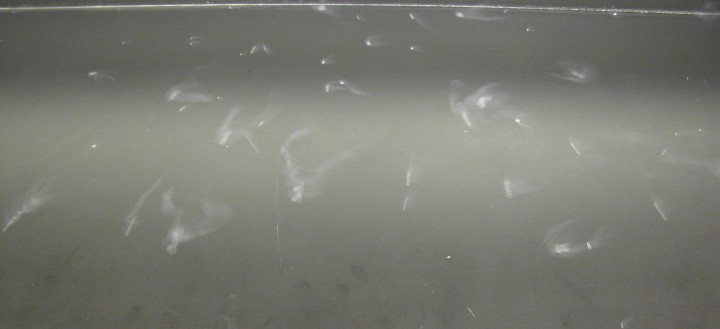Leidenfrost Effect with Liquid Nitrogen
Named after Johann Gottlob Leidenfrost, a German doctor, the Leidenfrost Effect is an occurrence where a liquid comes in contact with a material that is much hotter than its boiling point and creates a vapor layer to prevent it from further direct contact with the material. The liquid then boils much more slowly as it is protected by the insulating vapor layer. Liquid nitrogen on a smooth surface at room temperature can illustrate this phenomenon. The liquid nitrogen is obviously the liquid and the surface is the material that is much hotter than it. Droplets of the liquid nitrogen will move easily across the surface, supported on cushions of nitrogen vapor.
Reference:
Wikipedia: Leidenfrost effect. http://en.wikipedia.org/wiki/Leidenfrost_effect (accessed May, 2012).
BELOW: Droplets of liquid nitrogen exhibiting the Leidenfrost effect.
 Kylee Korte, Phuong Nguyen, and Joel Kouakou assisted in preparing these descriptions.
CAUTION: Liquid nitrogen is very cold and presents a serious frostbite hazard, especially if it gets trapped against your skin (e.g.in your clothing). Additionally, gaseous nitrogen occupies more volume than the same quantity of liquid nitrogen. Gaseous nitrogen produced quickly enough in sufficient quantities can displace oxygen from the air. Containers filled with liquid nitrogen could fail without warning due to thermal shock or gas pressure. Protect yourself accordingly. For a scary story about liquid nitrogen hazards, see: http://www.wpi.edu/news/19989/nitro.html.
Kylee Korte, Phuong Nguyen, and Joel Kouakou assisted in preparing these descriptions.
CAUTION: Liquid nitrogen is very cold and presents a serious frostbite hazard, especially if it gets trapped against your skin (e.g.in your clothing). Additionally, gaseous nitrogen occupies more volume than the same quantity of liquid nitrogen. Gaseous nitrogen produced quickly enough in sufficient quantities can displace oxygen from the air. Containers filled with liquid nitrogen could fail without warning due to thermal shock or gas pressure. Protect yourself accordingly. For a scary story about liquid nitrogen hazards, see: http://www.wpi.edu/news/19989/nitro.html.



No comments:
Post a Comment